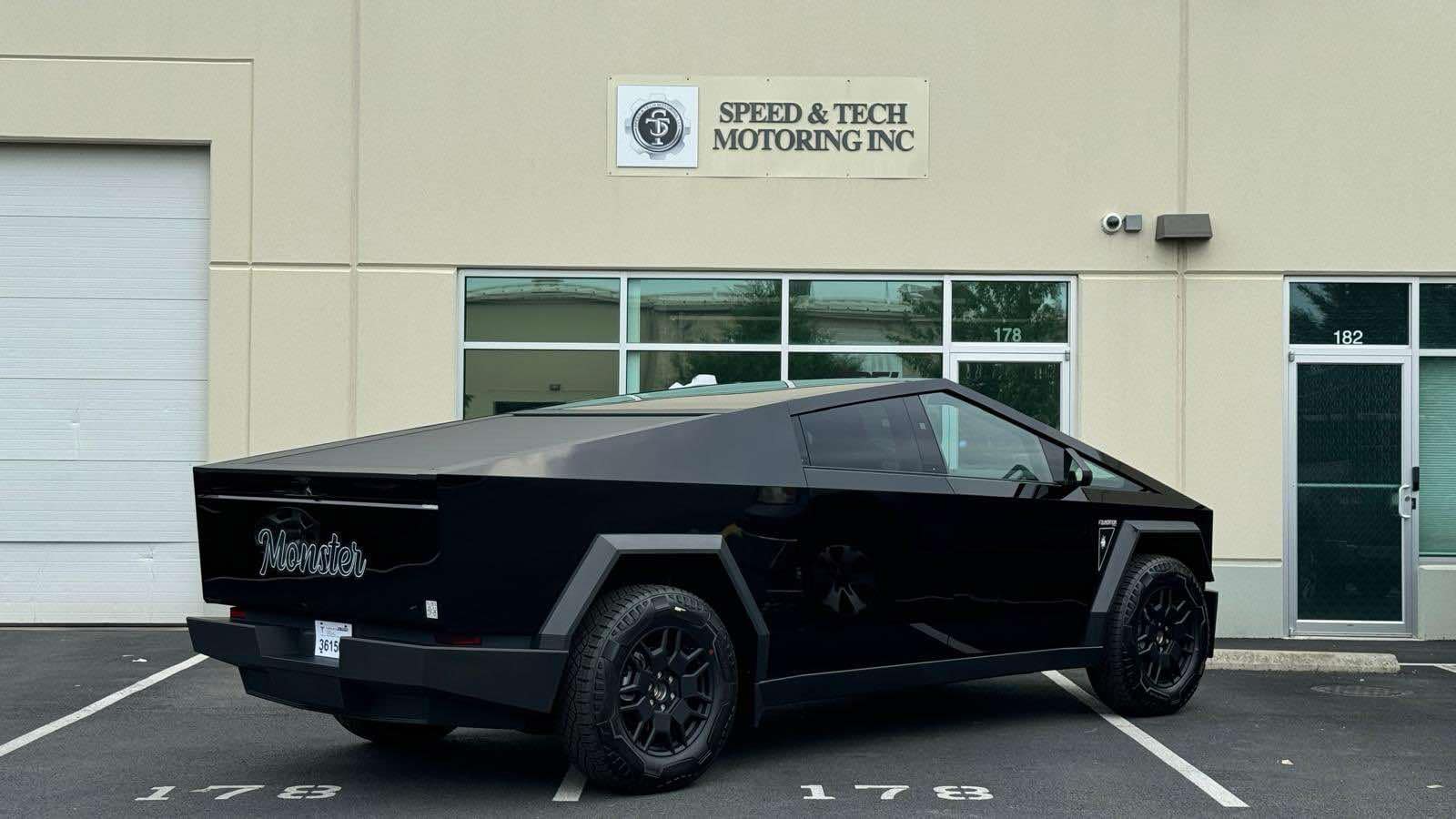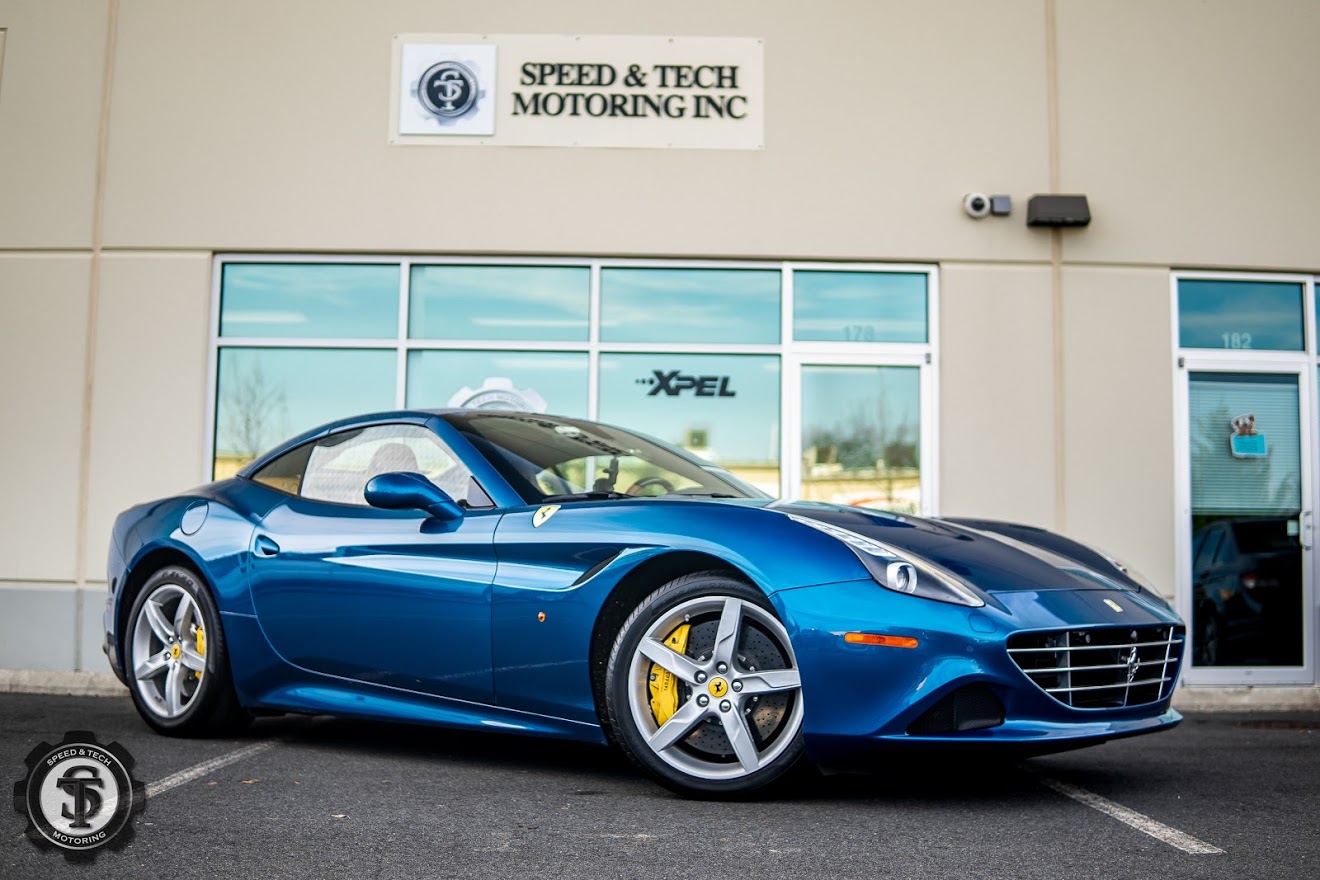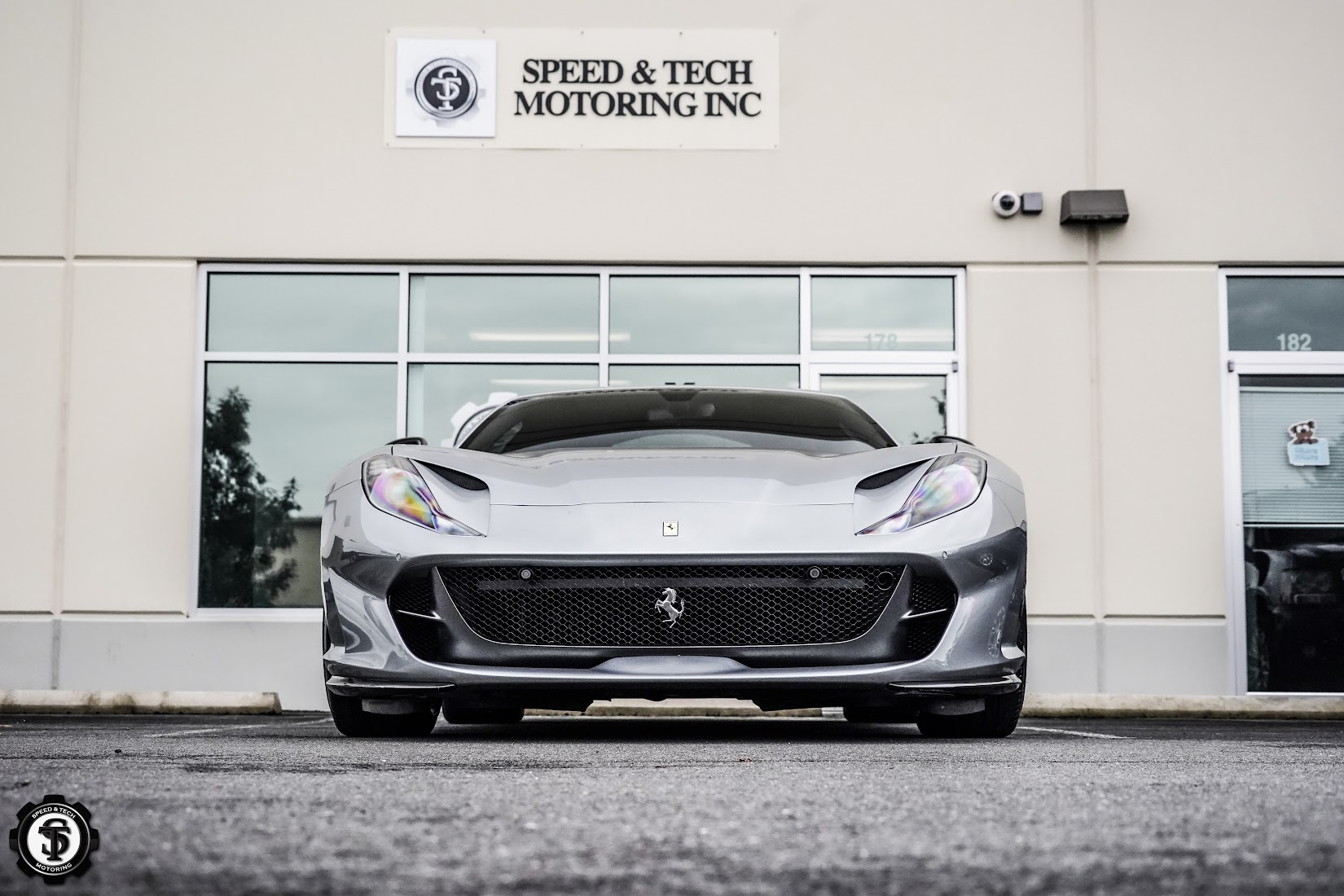Have you ever noticed how your car’s interior seems to age faster than the exterior? Maybe your dashboard has developed those telltale cracks, or your once-vibrant seats have faded to a dull shadow of their former glory. Here’s something most car owners don’t realize: your vehicle’s windows are basically letting in a barrage of damaging elements every single day. Window tinting isn’t just about looking cool or keeping your car comfortable—it’s one of the most effective ways to protect your interior investment from premature aging and deterioration.
Think about it this way: your car sits outside in parking lots, driveways, and streets, exposed to sunlight for hours on end. Without proper protection, those glass panes become gateways for destructive forces that slowly but surely break down everything inside. Let’s explore exactly how window tinting becomes your interior’s best defense against the elements.
Understanding the Enemy: What Damages Your Car’s Interior?
Before we talk about solutions, you need to understand what you’re fighting against. Your car’s interior faces multiple threats every day, and most of them come streaming through those clear windows.
UV Rays: The Silent Destroyer
Ultraviolet radiation is probably the biggest culprit when it comes to interior damage. These invisible rays penetrate through standard automotive glass and wreak havoc on everything they touch. UV rays break down the molecular structure of materials, causing them to become brittle, crack, and fade over time.
What makes UV damage so insidious is that you can’t see it happening until it’s too late. By the time you notice that your dashboard has cracked or your seats have faded, months or even years of cumulative damage have already occurred. UV exposure doesn’t just affect one part of your interior—it attacks everything simultaneously, from your steering wheel to your door panels.
Heat and Temperature Fluctuations
We’ve all experienced the shock of opening a car door on a hot day and being hit by that wall of scorching air. That intense heat isn’t just uncomfortable—it’s actively damaging your interior. High temperatures cause materials to expand, and when they cool down at night, they contract. This constant expansion and contraction cycle weakens structural integrity over time.
Temperature extremes also accelerate the chemical breakdown of materials like vinyl, leather, and plastic. That new car smell you love? It’s actually volatile organic compounds being released from your interior materials. When excessive heat speeds up this process, your interior ages much faster than it should.
Visible Light and Color Fading
Even regular sunlight, beyond just UV rays, contributes to interior deterioration. Visible light causes oxidation and chemical reactions in dyes and pigments, leading to that unfortunate fading effect. Dark colors are particularly vulnerable—black leather seats can turn grayish, and rich fabric tones become washed out.
The fading process isn’t uniform either. You’ll often notice that areas directly exposed to sunlight fade faster, creating an uneven, patchy appearance that makes your interior look older and poorly maintained.

How Window Tinting Acts as a Protective Shield
Now that you understand the threats, let’s talk about how window tinting provides comprehensive protection. Quality window films create a barrier between these damaging elements and your precious interior.
Blocking Harmful UV Radiation
This is where Window Tinting Sterling VA truly shines. High-quality tint films can block up to 99% of harmful UV rays. That’s not a small improvement—it’s nearly complete protection. When you have window tinting installed by professionals like those at Speed & Tech Motoring, you’re essentially creating an invisible shield that stops UV radiation in its tracks.
The film contains special compounds that absorb or reflect UV light before it can penetrate into your cabin. This means your dashboard, seats, door panels, and steering wheel are all protected from the molecular breakdown that UV exposure causes. It’s like applying sunscreen to your entire interior, except this protection lasts for years without needing reapplication.
Reducing Solar Heat Transmission
Window tinting doesn’t just block UV rays—it also significantly reduces the amount of heat that enters your vehicle. Depending on the type of film you choose, you can reduce solar heat transmission by 35% to 65%. That’s a massive difference in interior temperature.
When your interior stays cooler, several protective benefits occur. First, materials don’t experience those extreme temperature spikes that cause expansion and stress. Second, chemical degradation processes that are accelerated by heat slow down considerably. Third, your air conditioning doesn’t have to work as hard, which actually helps maintain more consistent interior temperatures overall.
Preventing Dashboard Cracks and Warping
Your dashboard is one of the most vulnerable parts of your interior, and it’s often the first place where sun damage becomes visible.
Why Dashboards Deteriorate Over Time
Dashboards are typically made from vinyl or polyurethane materials that are particularly susceptible to UV damage and heat. They sit directly in the sun’s line of fire, absorbing both UV radiation and intense heat day after day. The UV rays break down the plasticizers that keep the material flexible, while heat accelerates this process and causes the material to dry out.
As the dashboard loses its flexibility, it becomes brittle. When brittle material experiences the normal vibrations and temperature fluctuations of daily driving, cracks inevitably form. Once a crack starts, it typically spreads, and there’s no real way to fully repair it—you’re looking at expensive dashboard replacement.
Temperature Control Through Window Tinting
When you invest in window tinting, you’re dramatically reducing both UV exposure and heat buildup on your dashboard. The cooler temperatures mean less thermal stress, while the UV protection maintains the material’s flexibility for years longer than it would last otherwise.
Think of it this way: an untinted car’s dashboard might start showing cracks at five or six years old, while a properly tinted vehicle’s dashboard can remain crack-free for ten years or more. That’s essentially doubling the lifespan of this critical interior component through one protective measure.

Protecting Leather and Fabric Upholstery
Your seats represent a significant portion of your interior’s value and comfort. Whether you have luxurious leather or durable fabric, window tinting provides essential protection.
How UV Exposure Affects Different Materials
Leather is particularly vulnerable to UV damage. The natural oils and dyes in leather break down under UV exposure, causing the material to dry out, crack, and fade. You’ve probably seen older leather seats that look dried out and have developed that spiderweb pattern of cracks—that’s UV damage at work.
Fabric seats aren’t immune either. The dyes in fabric upholstery fade under UV exposure, and the fibers themselves can become weakened and brittle. Even synthetic fabrics designed for durability will eventually succumb to prolonged UV exposure without protection.
With window tinting in place, your upholstery receives up to 99% less UV exposure. This means the dyes stay vibrant, the materials maintain their suppleness, and the overall appearance remains much closer to new for significantly longer.
Maintaining That New Car Smell and Feel
There’s something special about the look and feel of fresh upholstery. Window tinting helps maintain that quality by preventing the accelerated aging that UV exposure and heat cause. Your seats will remain soft, comfortable, and visually appealing for years longer than they would in an untinted vehicle.
This isn’t just about aesthetics—it’s about functionality too. Cracked, dried-out leather isn’t just ugly; it’s uncomfortable and can even damage clothing. Faded fabric seats can transfer dye onto light-colored clothing. By preventing these issues through window tinting, you maintain both the appearance and functionality of your upholstery.
Reducing Interior Fading and Discoloration
Fading is one of the most visible signs of interior aging, and it affects virtually every surface inside your vehicle.
Understanding Color Degradation
Color fading occurs when UV rays and visible light break down the molecular bonds in dyes and pigments. Different colors fade at different rates—reds and purples typically fade fastest, while blacks and dark blues hold up better but still eventually fade.
The problem with fading is that it rarely happens uniformly. Areas directly exposed to sunlight through windows fade faster than shaded areas, creating an uneven appearance. Your driver’s seat might fade while the rear seats remain vibrant. One side of your dashboard might be noticeably lighter than the other.
This uneven fading is particularly frustrating because it makes your interior look neglected and poorly maintained, even if you’ve been careful about regular cleaning and conditioning.
Long-Term Aesthetic Benefits
Window tinting provides consistent protection across all interior surfaces. Because the film blocks UV rays and reduces visible light transmission uniformly across all windows, your entire interior ages at a much slower, more even pace.
Five years down the road, an untinted vehicle’s interior might look ten years old, while a properly tinted vehicle’s interior still looks relatively new. This difference becomes even more pronounced as vehicles age. At the ten-year mark, the contrast between tinted and untinted interiors is often dramatic.
Different Types of Window Tinting Solutions
Not all window tinting is created equal. Understanding your options helps you make an informed decision about the best protection for your vehicle.
Ceramic vs. Carbon vs. Dyed Films
Dyed films are the most economical option. They provide basic UV protection and heat reduction through light absorption. However, they tend to fade over time and offer the least heat rejection of all film types.
Carbon films offer a significant step up in performance. They provide excellent UV protection, superior heat rejection through infrared blocking, and don’t fade like dyed films. Carbon films also don’t interfere with electronic signals like GPS or cell phones.
Ceramic films represent the premium option. They offer the highest level of UV protection (99.9%), superior heat rejection (up to 65%), and exceptional clarity. Ceramic films maintain their effectiveness indefinitely without fading or degrading. They’re more expensive upfront, but their superior performance and longevity make them an excellent long-term investment.
Choosing the Right Tint for Your Needs
Your choice depends on several factors: budget, vehicle type, climate, and personal preferences. If you live in an extremely hot climate, investing in ceramic film makes sense due to its superior heat rejection. If budget is a primary concern but you still want good protection, carbon film offers an excellent middle ground.
The professionals at Speed & Tech Motoring can help you evaluate your specific needs and recommend the film type that provides the best balance of protection, performance, and value for your situation. They understand that every vehicle and every owner has different priorities.
Professional Installation: Why It Matters
You might be tempted to save money with a DIY tinting kit or bargain installation, but this is one area where professional expertise truly matters.
Proper installation requires specialized tools, controlled environment conditions, and experienced technique. Poorly installed tint develops bubbles, peels at the edges, interferes with visibility, and may even fail to provide the protective benefits you’re paying for.
Professional installers have the skills to properly prepare the glass, cut the film precisely, and apply it without bubbles or imperfections. They also understand local regulations regarding tint darkness and reflectivity, ensuring your vehicle remains legal.
Quality installers like Speed & Tech Motoring also provide warranties on both materials and workmanship. This means if any issues develop with your tint, they’ll correct them at no additional cost. That peace of mind is invaluable.
Professional installation also ensures you’re actually getting the UV protection and heat rejection the film is designed to provide. Improper installation can compromise these protective qualities, defeating the entire purpose of tinting your windows.
Maintaining Your Tinted Windows for Maximum Protection
Once you’ve invested in window tinting, proper maintenance ensures it continues protecting your interior for years to come.
Wait at least three to five days after installation before rolling down your windows. This allows the film to fully cure and adhere to the glass. Rolling windows down too soon can cause the film to peel or shift.
Clean your tinted windows with ammonia-free cleaners and soft microfiber cloths. Ammonia can damage window film over time, causing it to discolor or separate from the glass. Most quality window film manufacturers offer recommended cleaning products.
Avoid using abrasive materials or harsh chemicals on the interior side of your tinted windows. Rough scrubbing or aggressive cleaning products can scratch or damage the film surface.
Be cautious with sharp objects near your tinted windows. While quality film is durable, it can be scratched or torn by sharp edges. This is particularly important if you’re loading cargo or using window scrapers for ice removal.
Inspect your tint periodically for signs of damage like bubbling, peeling, or discoloration. If you notice any issues, contact your installation professional promptly. Many problems can be easily corrected if addressed early, but they become more serious if left unattended.
Speed & Tech Motoring Serving the Accotink Community and Beyond in Fort Belvoir, VA
Speed & Tech Motoring is dedicated to serving the diverse needs of the local community of Fort Belvoir, VA, including individuals residing in neighborhood like Accotink. With its convenient location near landmarks such as the Alexander T. Augusta Military Medical Center, Defense Acquisition University and major intersections like US-1 (Richmond Hwy) & Accotink Rd and US-1 & Belvoir Rd (entry toward base) (coordinates: 38.69419681510816, -77.15470096271085), we offer window tinting services.
Get Window Tinting Services at Accotink Now
Navigate from Accotink to Speed & Tech Motoring Now
Why Window Tinting Matters For Long-Term Car Upholstery Care?
- Blocks Over 99% of Harmful UV Rays Ceramic and advanced tint films reject nearly all UV radiation, preventing upholstery fading and cracking.
- Reduces Interior Heat by Up to 50% By lowering cabin temperatures, tinting slows material degradation caused by heat stress.
- Extends Upholstery Life by 3-5 Years on Average Studies show tinted windows significantly delay wear and discoloration of leather, vinyl, and fabric interiors.
- Market Growth Reflects Rising Consumer Awareness The automotive tinting film market reached $3.55B in 2024 and is projected to grow 4.9% annually through 2033, driven by demand for interior protection and UV safety.
Visual: Bar Chart Comparing Interior Temperature & UV Exposure
- Untinted vs Dyed Tint vs Carbon Tint vs Ceramic Tint
- Showing % UV Block and Average Interior Temp Reduction (°F)
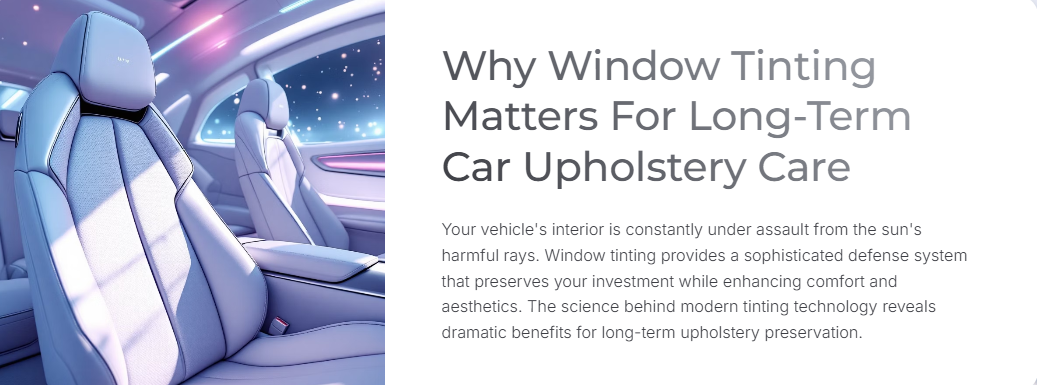
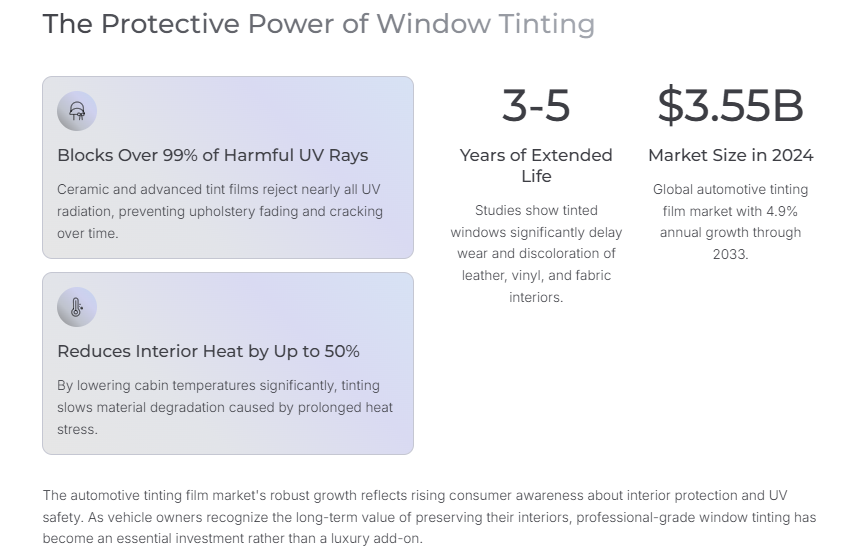
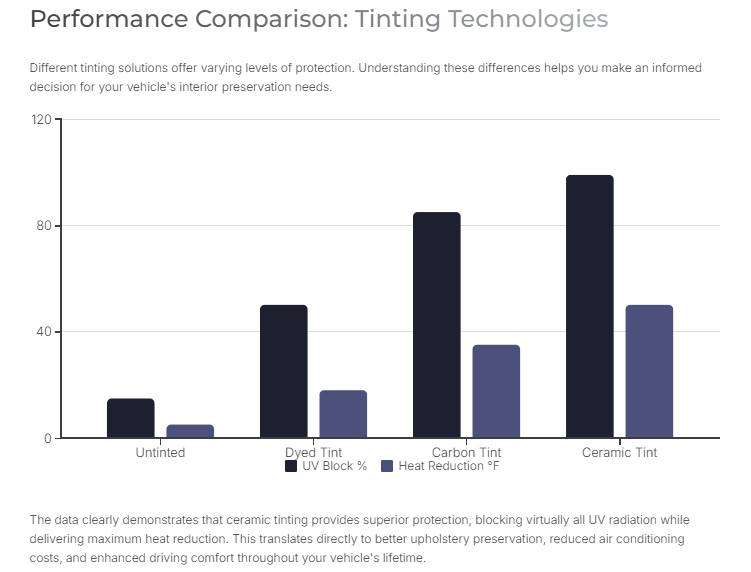
Sources: Grand View Research 2024, Accio 2025, Sun-Tint.com 2025, Straits Research 2025
Window tinting plays a crucial role in preserving your car’s upholstery and interior by creating a protective barrier against UV radiation, heat, and visible light—the primary causes of interior deterioration. By blocking up to 99% of harmful UV rays and significantly reducing heat transmission, quality window tinting prevents dashboard cracks, protects upholstery from fading and drying out, and maintains the overall aesthetic appeal of your interior for years longer than would otherwise be possible.
The benefits extend beyond preservation to include enhanced comfort, increased resale value, and significant cost savings compared to repairing or replacing damaged interior components. Whether you choose ceramic, carbon, or dyed film, professional installation by experts like Speed & Tech Motoring ensures you receive maximum protective benefits and long-lasting performance. Your vehicle’s interior represents a significant portion of your automotive investment—window tinting is one of the most effective and economical ways to protect that investment for the long term.
FAQs
How much UV protection does window tinting actually provide?
High-quality window tinting blocks up to 99.9% of harmful UV rays, providing nearly complete protection for your interior. Even basic tint films block at least 95% of UV radiation, which is significantly more protection than untinted windows that only block about 40% of UV rays.
Will window tinting completely prevent my interior from fading?
While window tinting dramatically slows the fading process by blocking UV rays and reducing heat and visible light transmission, it cannot completely eliminate all fading indefinitely. However, it can extend the life of your interior by several years and reduce fading by approximately 60-80% compared to untinted windows.
How long does window tinting last before it needs replacement?
Quality window tinting installed professionally can last 10-15 years or longer with proper care. Ceramic and carbon films typically outlast dyed films, which may begin to fade or purple after 5-7 years. The longevity depends on film quality, installation expertise, climate conditions, and maintenance practices.
Can I tint my windows myself or should I use a professional service?
While DIY tinting kits are available, professional installation is strongly recommended. Proper installation requires specialized tools, controlled conditions, and experienced technique to avoid bubbles, proper edge sealing, and ensure full protective benefits. Professional installers also provide warranties and ensure compliance with local tinting regulations.
Does window tinting interfere with GPS, cell phone signals, or electronic devices?
Modern carbon and ceramic window tinting does not interfere with electronic signals. Older metallic films could cause signal interference, but current technology has eliminated this issue. Quality films are specifically designed to allow radio frequencies to pass through while blocking heat and UV radiation.
Our Other Blog Posts Related Window Tinting
How Window Tinting Films Differ And Their Unique Benefits
How Window Tinting Improves Privacy While Maintaining Clear Views
What Window Tinting Options Provide Strongest UV Defense
How Long Does Window Tinting Last? Expert Tips to Extend Its Life

